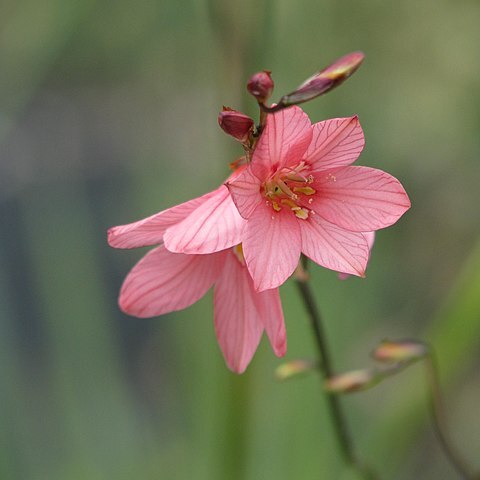Plants (200-)300-500(-800) mm high. Corm subglobose to depressed-globose, 10-30 mm diam.; tunics of fine fibres, sometimes extending in a fibrous or papery collar. Stem erect or flexed outward above upper leaf and slightly inclined, simple or with up to 2(3) suberect branches from upper 1/2. Leaves 5 to 8, suberect, firm-textured, narrowly lanceolate, (100-)150-300(-500) x (5-)8-12(-20) mm, acute or acuminate, with raised main vein and strong submarginal vein ± 1 mm from margin, often reaching base of spike, usually forming a pseudostem at base, cauline leaves ± overlapping in lower 1/2 of stem, uppermost dry and clasping, bract-like. Spike suberect or inclined, ± 2-ranked, moderately dense or lax, 4-to 12(-15)-flowered; bracts dry and papery, pale translucent or straw-coloured below, densely speckled and flecked with dark brown above or at tips, often striate with brown veins, (8-)10-15(-18) mm long, acute to acuminate, obtuse, or minutely ± 3-toothed with middle tooth reduced, inner slightly shorter, bifid. Flowers slightly zygomorphic, bright red, orange red or pink, lower tepals with a small yellow blotch sometimes outlined with red, sometimes smaller on laterals, tepals sometimes prominently dark-veined, unscented; perianth tube obliquely funnel-shaped, (8-)12-16 mm long with basal 2-3 mm narrow, curved outward, widening up to 8-10 mm diam.; tepals oblong to obovate, (10-)15-18(-20) mm long, obtuse, spreading, dorsal slightly wider, 8-10 mm wide, others 5-8 mm wide, lower median sometimes with a low thickened basal ridge. Filaments unilateral, arcuate, 7-12 mm long, included or exserted up to 3 mm; anthers 5-7 mm long, curved, apiculate, pink or yellow. Style dividing between middle and apex of anthers or sometimes beyond, branches 2-4 mm long. Capsules subglobose or obovoid, ± 10 mm long.
More
Perennial herb, geophyte, 0.25-0.80 m high; corm depressed-globose to ovoid, tunics of elongated reticulate fibres; stem simple or 1-3-branched, sometimes slightly flexuose. Leaves linear to linear-lanceolate, (sub)erect, acute to acuminate, with strong midline vein, turning darker when dry. Bracts membranous, golden-brown, margins papery; outer tridentate; inner bidentate. Inflorescence with red, pink or orange-red, zygomorphic flowers; perianth tube funnel-shaped; tepals elliptical, obtuse, spreading, subequal in length, lower with yellow blotch in throat. Stamens curved; filaments 7-12 mm long; anthers curved, pink or yellow. Flowering time Aug.-Apr. Capsule subglobose or obovoid.

